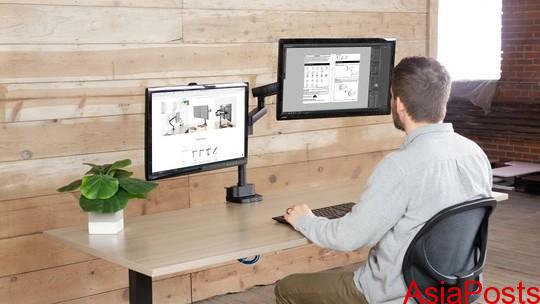Many dual display arms look pretty close on the floor, but there are some important differences that you should be cautious when searching for the best monitor stand for your needs. We’ll break down the important distinctions to make below as well as discuss some of the most frequently asked questions we get about desk monitors.
Type of Monitor Arms
Dual monitor arms aren’t almost as identical on the surface as they often appear. Unfortunately, there is a great deal of variance in how these tools function in a basic way and making things even more complicated is that many versions fall into multiple categories. Let’s break down the jargon so you can choose your home or office desk for the best stand.
In its own foundation is a freestanding dual display stand. Which comes with a variety of benefits. When you are constantly rearranging your desk or plan to use it in more configurations, a standing monitor table is the perfect option.
These appear to be smaller and can be balanced from a number of angles. But because they do need to be positioned on top of your desk, they don’t allow you to make the most of your desk space.
A dual display clamping stand is the best choice if you are really looking to make the most of your desk space. You use a C-clamp which locks quickly on the side of your desk, and the straight pole which serves as the base give way to adjustable dual display arms.
Usually, these styles of stands do not require any pounding, and you don’t even need to hurt your desk to lock in the display stand.
If you are trying to install the display stand against the side of your seat, a grommet dual monitor stand is an acceptable best option. Compared to clamping tables, you don’t need to hammer a grommet brace into your desk at all.
The one downside is that a thinner desk surface is generally required to be correctly fastened and locked into place. Many of the best monitor stands come with either a C-clamp or a grommet capability.
A riser will pose as either a freestanding model or a clamp or grommet device, and as you might imagine, a riser profits from a better range of height adjustment than you would find in a more conventional display screen stand. It is subjective whether or not that adjustable height will be beneficial to you.
A riser is usually best suited to lower-height benches, and in that situation, the riser’s ability to adjust the height is a valuable tool to create a more ergonomic environment for your computers. A riser is usually best geared for desks of lower heights, and in that case, the capacity of the riser to raise the height is a valuable tool in designing a more ergonomic space for your displays.
Innovative and ergonomic monitor arms can be bought at Jestik. Get yours now!



























































